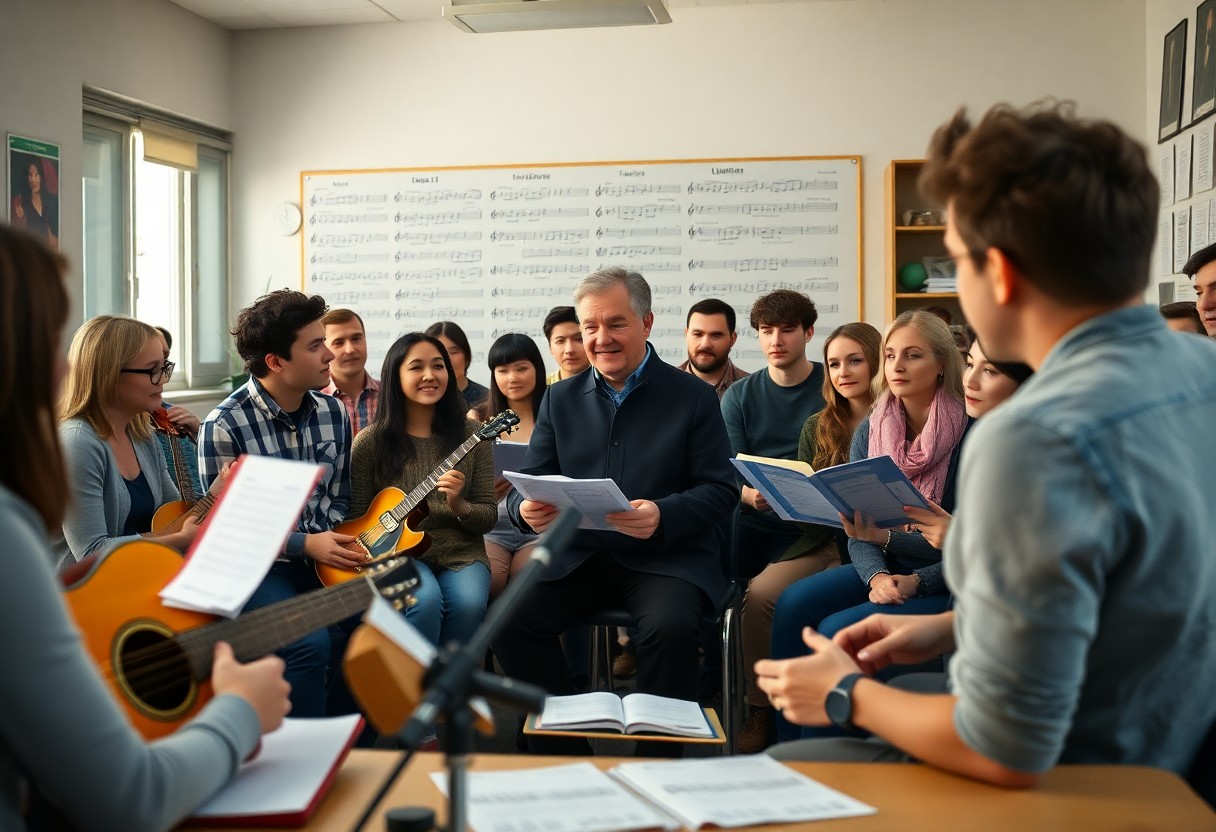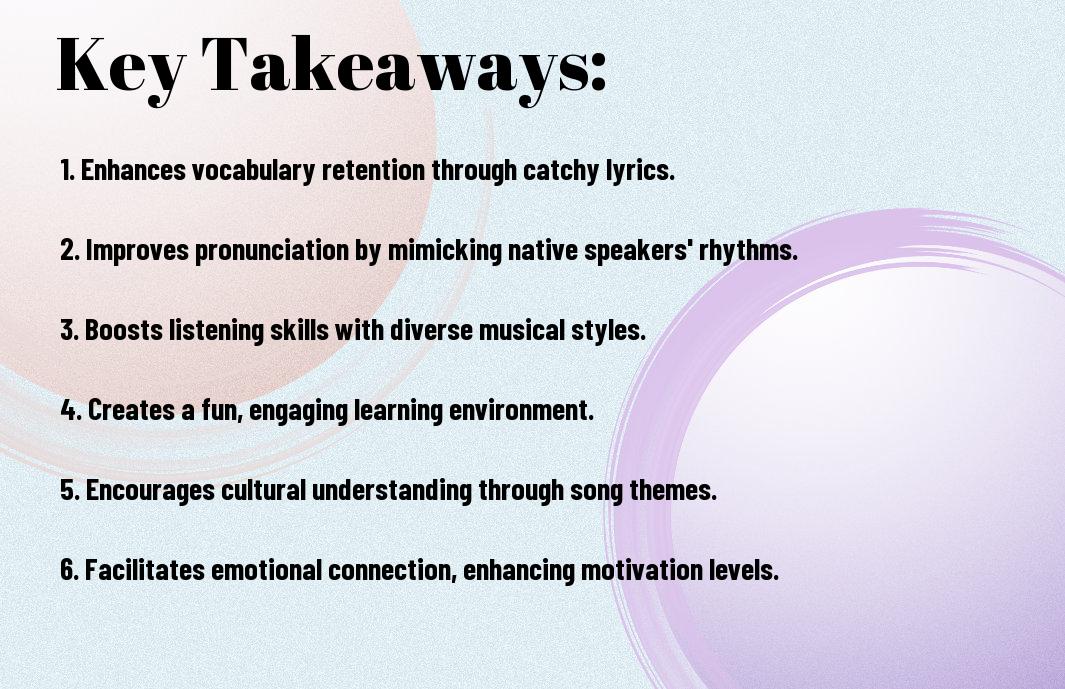As you initiate on learning a new language, you may find yourself exploring various methods to enhance your understanding and retention. Your approach to language learning can be significantly influenced by the tools you use, and music is one such tool that can have a profound impact. You will discover that music can facilitate your language learning process, making it more enjoyable and effective, and this article will probe into the ways music can aid in your linguistic development.
Key Takeaways:
- The connection between music and language learning is deeply rooted in the way our brains process rhythms and melodies, making music an effective tool for language acquisition.
- Listening to music in the target language can help learners develop their phonological awareness and improve their pronunciation skills.
- Singing songs in the target language can aid in vocabulary acquisition and grammar practice, as it provides a fun and engaging way to memorize new words and phrases.
- The use of lyrics and music videos can provide valuable contextual information and help learners understand the cultural nuances of the target language.
- Music-based language learning activities can increase motivation and engagement among learners, leading to a more enjoyable and effective language learning experience.

The Cognitive Benefits of Music in Language Learning
Your brain is wired to respond to music, and research has shown that it can have a significant impact on your ability to learn new languages. Music can aid in language acquisition by stimulating your cognitive abilities and improving your focus.
Enhanced Memory and Recall
Following the initial exposure to a new language, subsequent listening to music in that language can enhance your memory and facilitate recall of new vocabulary and grammar rules.
Improved Language Processing
Along with the benefits of enhanced memory, music can also improve your language processing skills, allowing you to better understand and interpret the nuances of the language.
This improvement in language processing is largely due to the fact that music helps you develop your phonological awareness, which is crucial for distinguishing between similar sounds and intonations in the new language, enabling you to communicate more effectively and accurately express your thoughts and ideas.

The Role of Rhythm and Melody in Language Acquisition
Clearly, rhythm and melody play a significant role in language acquisition, as they help you internalize the sound and structure of a new language. You can learn more about how music aids in language learning by visiting 6 Ways Music Can Help You Learn A Foreign Language, which provides valuable insights into this topic.
Phonological Awareness and Intonation
About the connection between music and phonological awareness, you’ll find that melody and rhythm help your brain recognize patterns and intonation in speech, making it easier to understand and mimic native speakers.
Syllable Stress and Pronunciation
Stress patterns in music can aid your pronunciation skills, as you learn to emphasize the correct syllables in words, improving your overall speech.
This understanding of syllable stress and pronunciation can be further developed by listening to songs and repeating the lyrics, allowing you to practice your language skills in a more engaging and effective way, and as you progress, you’ll notice improvements in your ability to communicate in your target language.
Music as a Tool for Vocabulary Building
After learning a new language, you can use music to build your vocabulary. You can listen to songs, identify unfamiliar words, and look them up in a dictionary to learn their meanings. This method helps you learn new words in context, making it easier to understand and use them in your own sentences.
Lyrical Analysis and Contextual Learning
Analyzing song lyrics helps you learn vocabulary in context. You can break down the lyrics, look up unfamiliar words, and understand how they are used in different sentences. This approach enables you to learn vocabulary naturally, as you would in a conversation.
Musical Genre and Cultural Immersion
Along with vocabulary building, music can also help you learn about different cultures. You can listen to traditional music from the country where your target language is spoken, and learn about the customs and traditions associated with it. This approach helps you develop a deeper understanding of the language and its cultural context.
At this point, you may be wondering how to choose the right music for language learning. You can start by selecting songs with clear lyrics and a slow tempo, making it easier to follow and understand the words. You can also explore different musical genres, such as folk or pop, to find the style that suits your taste and learning preferences. By doing so, you can create a personalized playlist that helps you learn your target language in a fun and engaging way.
The Impact of Music on Language Motivation and Engagement
Not surprisingly, music has a profound effect on your motivation to learn a new language, making the process more enjoyable and increasing your engagement with the material.
Emotional Connection and Enjoyment
Beneath the surface of language learning, you will find that music helps create an emotional connection, making the experience more enjoyable and increasing your willingness to participate in language learning activities.
Social Interaction and Community Building
Surrounding yourself with others who share your interest in music and language can facilitate social interaction, helping you build a community of fellow learners who support and motivate you in your language learning journey.
Considering the social aspect of music in language learning, you will find that singing along to your favorite songs or participating in music-based language exchange events can help you meet new people and practice your language skills in a more relaxed and informal setting, which can be highly beneficial for your language development and motivation to continue learning.
The Neuroscience of Music and Language Learning
Unlike other methods, music-based language learning taps into your brain’s ability to process multiple stimuli simultaneously, making it an effective tool for language acquisition. As you engage with music, your brain creates connections between sounds, rhythm, and meaning, which can aid in language learning.
Brain Plasticity and Neurological Connections
At the heart of music’s impact on language learning lies your brain’s ability to reorganize itself in response to new experiences. As you learn a new language through music, your brain forms new neurological connections, strengthening your ability to process and retain language information.
The Role of Dopamine and Reward Systems
Against the backdrop of language learning, music activates your brain’s reward system, releasing dopamine and motivating you to continue learning. This feedback loop of pleasure and reward helps solidify language patterns in your mind, making it easier to recall and use them in context.
Learning a new language through music can have a profound impact on your brain’s reward system. As you begin to grasp the rhythms and melodies of a new language, your brain releases dopamine, reinforcing the behavior and motivating you to continue practicing. This can lead to a snowball effect, where your progress in language learning fuels your desire to learn more, and your brain’s reward system responds in kind, releasing more dopamine and solidifying the new language patterns in your mind. You will find that the more you engage with music-based language learning, the more your brain adapts and grows, ultimately leading to greater language proficiency and a deeper understanding of the language and its cultural context.
Practical Applications of Music in Language Instruction
All language learners can benefit from music-based instruction, as you can discover more about Learning Language through Music: Science and Songs to enhance your learning experience.
Song-Based Lesson Plans and Activities
Actions like singing and dancing can engage you in the learning process, making it more enjoyable and interactive, as you explore song-based lesson plans and activities to improve your language skills.
Technology-Integrated Music Learning Tools
Instructional methods that incorporate music and technology can facilitate your language learning, providing you with a wide range of resources and tools to practice and improve your language proficiency.
In addition, you can utilize various online platforms and apps that offer music-based language lessons, allowing you to access a vast library of songs, lyrics, and interactive exercises tailored to your language level and interests, helping you to develop your listening, speaking, reading, and writing skills in a more engaging and effective way.
Conclusion
Taking this into account, you can see how music facilitates your language learning process. As you engage with songs and melodies in your target language, your brain absorbs grammar and vocabulary more effortlessly. Your comprehension and pronunciation improve, making you a more confident learner. By leveraging music, you enhance your overall learning experience, making it more enjoyable and effective.
FAQ
Q: How can music enhance the learning experience for individuals trying to acquire a new language?
A: Music plays a significant role in language learning as it helps to create a multisensory experience, engaging both the auditory and visual senses. By incorporating songs, rhymes, and melodies into the learning process, individuals can improve their pronunciation, intonation, and comprehension skills. Music also has the ability to evoke emotions and create a positive association with the language, making the learning process more enjoyable and increasing motivation. Additionally, music can aid in memory consolidation, with catchy tunes and rhythms helping to encode new vocabulary and grammatical structures in the brain.
Q: What are some effective ways to use music in language learning, and how can learners apply these methods in their daily practice?
A: There are several ways to utilize music in language learning, including listening to songs in the target language, singing along to improve pronunciation, and using music-based language learning apps. Learners can also create playlists of songs that correspond to specific grammar or vocabulary topics, and use the lyrics to practice reading and listening comprehension. Furthermore, music can be used as a tool for pronunciation practice, with learners mimicking the intonation and rhythm of native speakers. By incorporating music into their daily routine, learners can make language practice more engaging, interactive, and fun, and can ultimately improve their overall language proficiency.
Q: Can music help learners overcome language barriers and cultural differences, and how can it facilitate communication with native speakers?
A: Music has the power to transcend language barriers and cultural differences, providing a universal means of communication and expression. By exploring music from the target culture, learners can gain insight into the customs, traditions, and values of the native speakers, and develop a deeper understanding of the language in context. Music can also serve as a common ground for communication, allowing learners to connect with native speakers through a shared interest or passion. Additionally, music can help learners to develop their speaking skills, with conversations about music providing a natural and authentic context for practicing language exchange. By leveraging the power of music, learners can break down cultural and linguistic barriers, and build bridges of understanding with native speakers.
